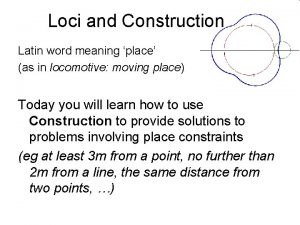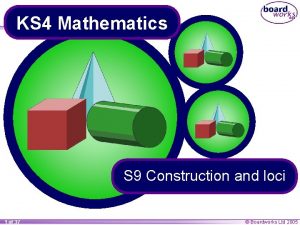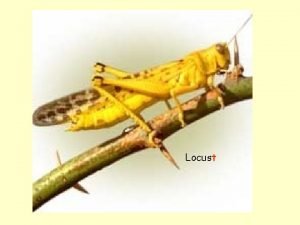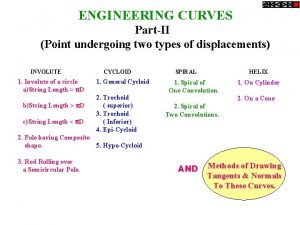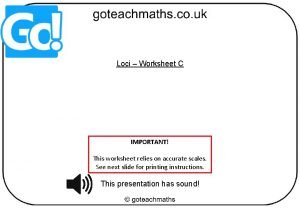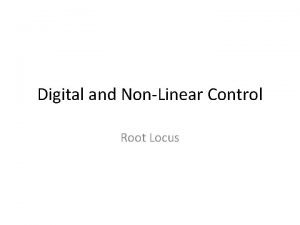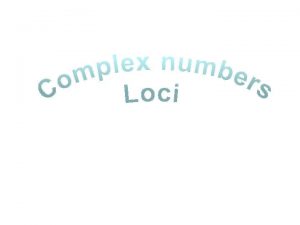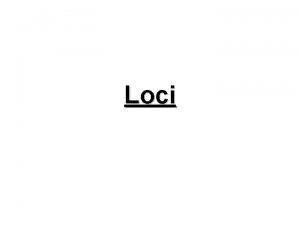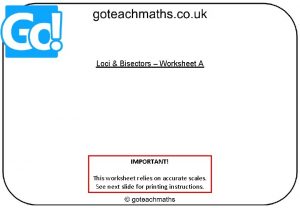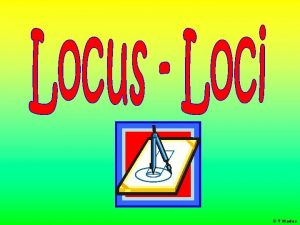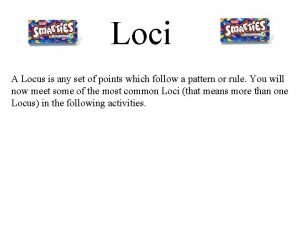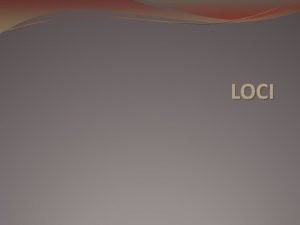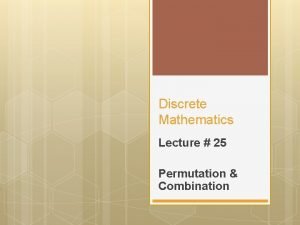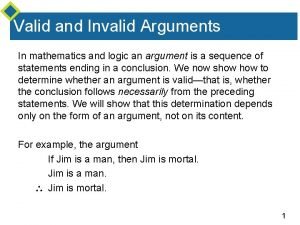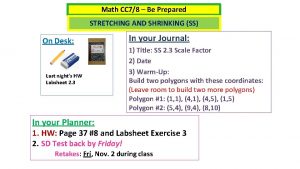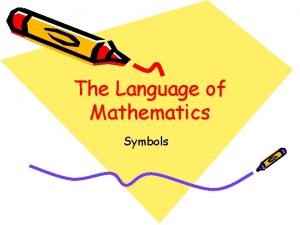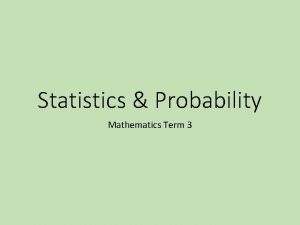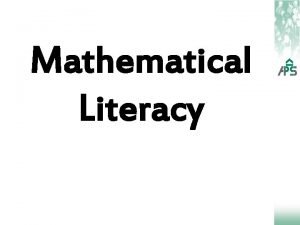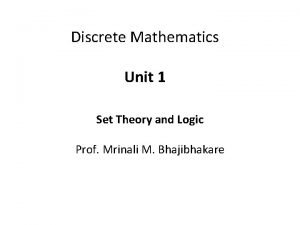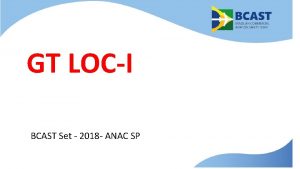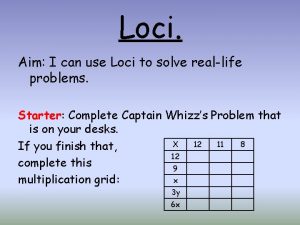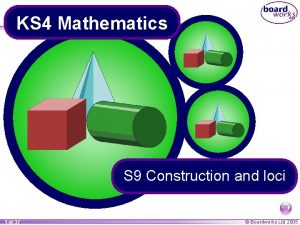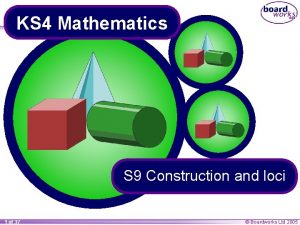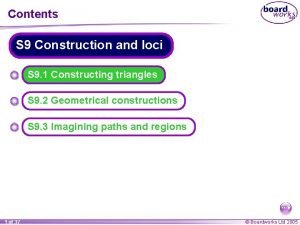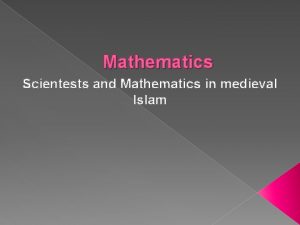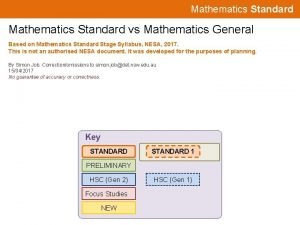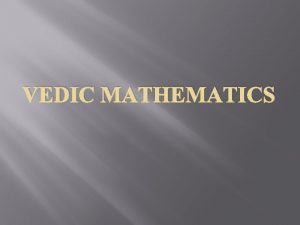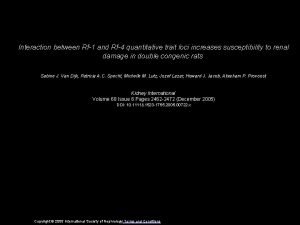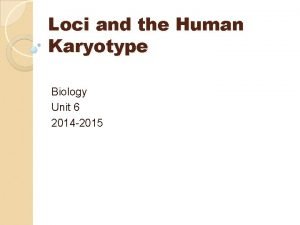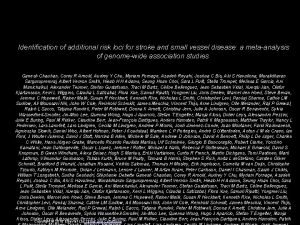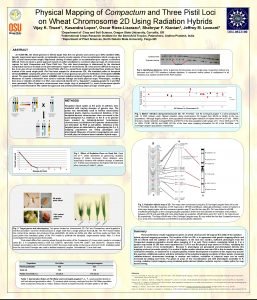KS 4 Mathematics S 9 Construction and loci





































- Slides: 37

KS 4 Mathematics S 9 Construction and loci 1 of 37 © Boardworks Ltd 2005

Contents S 9 Construction and loci A S 9. 1 Constructing triangles A S 9. 2 Geometrical constructions A S 9. 3 Imagining paths and regions A S 9. 4 Loci A S 9. 5 Combining loci 2 of 37 © Boardworks Ltd 2005

Equipment needed for constructions Before you begin make sure you have the following equipment: 3 of 37 A ruler marked in cm and mm A protractor A pair of compasses A sharp pencil © Boardworks Ltd 2005

Constructing triangles To accurately construct a triangle you need to know: The length of two sides and the included angle (SAS) The size of two angles and a side (ASA) The lengths of all three sides (SSS) or A right angle, the length of the hypotenuse and the length of one other side (RHS) 4 of 37 © Boardworks Ltd 2005

Constructing a triangle given SAS How could we construct a triangle given the lengths of two of its sides and the angle between them? side angle side The angle between the two sides is often called the included angle. We use the abbreviation SAS to stand for Side, Angle and Side. 5 of 37 © Boardworks Ltd 2005

Constructing a triangle given SAS 6 of 37 © Boardworks Ltd 2005

Constructing a triangle given ASA How could we construct a triangle given two angles and the length of the side between them? angle side The side between the two angles is often called the included side. We use the abbreviation ASA to stand for Angle, Side and Angle. 7 of 37 © Boardworks Ltd 2005

Constructing a triangle given ASA 8 of 37 © Boardworks Ltd 2005

Constructing a triangle given SSS How could we construct a triangle given the lengths of three sides? side Hint: We would need to use a pair of compasses. We use the abbreviation SSS to stand for Side, Side. 9 of 37 © Boardworks Ltd 2005

Constructing a triangle given SSS 10 of 37 © Boardworks Ltd 2005

Constructing a triangle given RHS Remember, the longest side in a right-angled triangle is called the hypotenuse. How could we construct a right-angled triangle given the right angle, the length of the hypotenuse and the length of one other side? hypotenuse right angle side We use the abbreviation RHS to stand for Right angle, Hypotenuse and Side. 11 of 37 © Boardworks Ltd 2005

Constructing a triangle given RHS 12 of 37 © Boardworks Ltd 2005

Contents S 9 Construction and loci A S 9. 1 Constructing triangles A S 9. 2 Geometrical constructions A S 9. 3 Imagining paths and regions A S 9. 4 Loci A S 9. 5 Combining loci 13 of 37 © Boardworks Ltd 2005

Bisecting lines Two lines bisect each other if each line divides the other into two equal parts. For example, line CD bisects line AB at right angles. C A B D We indicate equal lengths using dashes on the lines. When two lines bisect each other at right angles we can join the end points together to form a rhombus. 14 of 37 © Boardworks Ltd 2005

Bisecting angles A line bisects an angle if it divides it into two equal angles. For example, in this diagram line BD bisects ABC. A D B 15 of 37 C © Boardworks Ltd 2005

The perpendicular bisector of a line 16 of 37 © Boardworks Ltd 2005

The bisector of an angle 17 of 37 © Boardworks Ltd 2005

The perpendicular from a point to a line 18 of 37 © Boardworks Ltd 2005

The perpendicular from a point on a line 19 of 37 © Boardworks Ltd 2005

Contents S 9 Construction and loci A S 9. 1 Constructing triangles A S 9. 2 Geometrical constructions A S 9. 3 Imagining paths and regions A S 9. 4 Loci A S 9. 5 Combining loci 20 of 37 © Boardworks Ltd 2005

Imagining paths A locus is a set of points that satisfy a rule or set of rules. The plural of locus is loci. We can think of a locus as a path or region traced out by a moving point. For example, Imagine the path traced by a football as it is kicked into the air and returns to the ground. 21 of 37 © Boardworks Ltd 2005

Imagining paths The path of the ball as it travels through the air will look something like this: The shape of the path traced out by the ball has a special name. Do you know what it is? This shape is called a parabola. 22 of 37 © Boardworks Ltd 2005

Imagining paths Some fluffy dice hangs from the rear-view mirror in a car and swing from side to side as the car moves forwards. Can you imagine the path traced out by one of the die? How could you represent the path in two dimensions? What about in three dimensions? 23 of 37 © Boardworks Ltd 2005

Imagining paths A nervous woman paces up and down in one of the capsules on the Millennium Eye as she ‘enjoys’ the view. Can you imagine the path traced out by the woman? How could you represent the path in two dimensions? What about in three dimensions? 24 of 37 © Boardworks Ltd 2005

Imagining regions Franco promises free delivery for all pizzas within 3 miles of his Pizza House. Franco’s Pizza House is not drawn to scale! 3 miles Can you describe the shape of the region within which Franco can deliver his pizzas free-of-charge? 25 of 37 © Boardworks Ltd 2005

Grazing sheep 26 of 37 © Boardworks Ltd 2005

Contents S 9 Construction and loci A S 9. 1 Constructing triangles A S 9. 2 Geometrical constructions A S 9. 3 Imagining paths and regions A S 9. 4 Loci A S 9. 5 Combining loci 27 of 37 © Boardworks Ltd 2005

The locus of points from a fixed point Imagine placing counters so that their centres are always 5 cm from a fixed point P. 5 cm P Describe the locus made by the counters. The locus is a circle with a radius of 5 cm and centre at point P. 28 of 37 © Boardworks Ltd 2005

The locus of points from a line segment Imagine placing counters so that their centres are always 3 cm from a line segment AB. A B Describe the locus made by the counters. The locus is a pair of parallel lines 3 cm either side of AB. The ends of the line AB are fixed points, so we draw semi-circles of radius 3 cm. 29 of 37 © Boardworks Ltd 2005

The locus of points from two fixed points Imagine placing counters so that they are always an equal distance from two fixed points P and Q. P Q Describe the locus made by the counters. The locus is the perpendicular bisector of the line joining the two points. 30 of 37 © Boardworks Ltd 2005

The locus of points from two lines Imagine placing counters so that they are an equal distance from two straight lines that meet at an angle. Describe the locus made by the counters. The locus is the angle bisector of the angle where the two lines intersect. 31 of 37 © Boardworks Ltd 2005

The locus of points from a given shape Imagine placing counters so that they are always the same distance from the outside of a rectangle. Describe the locus made by the counters. The locus is not rectangular, but is rounded at the corners. 32 of 37 © Boardworks Ltd 2005

The locus of points from a given shape 33 of 37 © Boardworks Ltd 2005

Contents S 9 Construction and loci A S 9. 1 Constructing triangles A S 9. 2 Geometrical constructions A S 9. 3 Imagining paths and regions A S 9. 4 Loci A S 9. 5 Combining loci 34 of 37 © Boardworks Ltd 2005

Combining loci Suppose two goats, Archimedes and Babbage, occupy a fenced rectangular area of grass of length 18 m and width 12 m. Archimedes is tethered so that he can only eat grass that is within 12 m from the fence PQ and Babbage is tethered so that he can only eat grass that is within 14 m of post R. Describe how we could find the area that both goats can graze. 35 of 37 © Boardworks Ltd 2005

Tethered goats 36 of 37 © Boardworks Ltd 2005

The intersection of two loci Suppose we have a red counter and a blue counter that are 9 cm apart. 6 cm Draw an arc of radius 6 cm from the blue counter. 5 cm 9 cm 6 cm 5 cm Draw an arc of radius 5 cm from the red counter. How can we place a yellow counter so that it is 6 cm from the blue counter and 5 cm from the red counter? There are two possible positions. 37 of 37 © Boardworks Ltd 2005
 Latin words
Latin words Loci and construction grade 9
Loci and construction grade 9 Locusthepath
Locusthepath What is root locus in control system
What is root locus in control system Engineering curves
Engineering curves The method of loci
The method of loci The persistence of learning over time
The persistence of learning over time Loci worksheet
Loci worksheet Loci of conflict
Loci of conflict Loci questions
Loci questions Commutatio loci
Commutatio loci Root locus break in and break away points
Root locus break in and break away points Loci on argand diagram
Loci on argand diagram Fokus lokus adalah
Fokus lokus adalah The locus rule
The locus rule Loci worksheet
Loci worksheet Three loci of conflict
Three loci of conflict Chromosomes
Chromosomes Locus of a rectangle
Locus of a rectangle The locus rule
The locus rule Locus of points inside triangle
Locus of points inside triangle Loci worksheet
Loci worksheet Using mathematics and computational thinking
Using mathematics and computational thinking Business mathematics chapter 1 ppt
Business mathematics chapter 1 ppt Permutation and combination in discrete mathematics
Permutation and combination in discrete mathematics Onto function
Onto function Topic 3 the mathematics of formulas and equations
Topic 3 the mathematics of formulas and equations Valid or invalid argument
Valid or invalid argument What is his favorite subject?
What is his favorite subject? Stretching and shrinking math book
Stretching and shrinking math book Transition to college mathematics and statistics
Transition to college mathematics and statistics At most symbol
At most symbol Learning intentions and success criteria for mathematics
Learning intentions and success criteria for mathematics Difference between mathematics and mathematical literacy
Difference between mathematics and mathematical literacy International journal of science and mathematics education
International journal of science and mathematics education Bfs in discrete mathematics
Bfs in discrete mathematics Laws of set theory in discrete mathematics
Laws of set theory in discrete mathematics Induction and recursion discrete mathematics
Induction and recursion discrete mathematics
